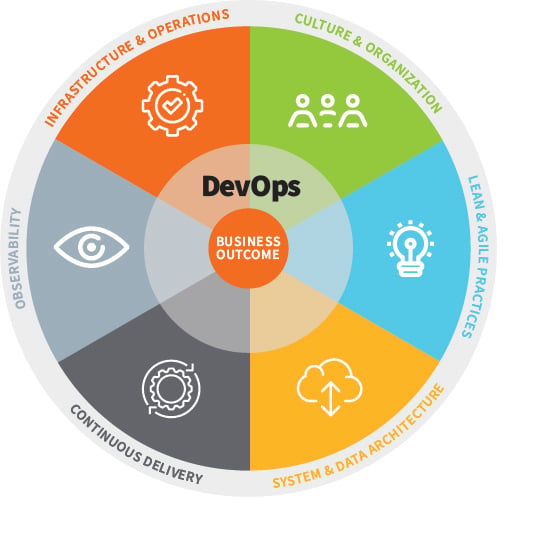The path to successful DevOps transformation is not straight and steady, nor does it look the same for everyone. With success stories like Amazon, Facebook, and Google leading the way, it's no surprise that IT leaders are turning to DevOps as a means to revolutionize their business. But without clear direction, IT organizations can feel stifled, overwhelmed, and unsure where to begin.
Whatever your situation, a successful DevOps implementation can begin with just a few simple steps. To set you off on the right foot, here are three ways to start DevOps the RIGHT way.
Step 1: Define Your "Why"
The first step to any DevOps transformation is to establish your “why.” Without it, you may be tricked into “doing DevOps” without ever knowing what you’re trying to achieve. Though your DevOps goals may look different from those around you, identifying a solid business justification will provide vision, emphasize business outcomes, and keep you from getting too sucked into the tools and processes along the way. As Gartner states, “The most successful organizations know the business benefits they hope to realize from DevOps.”
Not only will your business justification create focus for you as a leader, but it’s also a great way to get senior leadership on your side. According to the Veracity Guidebook: Navigating Your DevOps Journey, “Grounding the organization (and especially executive management) in a solid justification will significantly reduce friction, create buy-in, and provide solidarity when things don’t go as well as planned.” (Esser, 2). Defining your "why" is the crucial first step to set up your organization for long-term DevOps success.
EXAMPLES FROM A VERACITY EXPERT:
After an experience with a client, one of our Veracity experts emphasized the importance of establishing the right business justification to achieve the desired result. He reports:

"When we first began, the CTO was uncertain of where our priorities should lie. Do we focus on improving the delivery pipeline (CI/CD) or new feature development? We had learned through past experiences that poor delivery caused frustration across the organization, and the inability to receive production and staging feedback hindered our ability to show real progress.
I explained how critical it was to deploy quickly and that the speed at which we deploy could determine the success or failure of future projects. It turns out, had we not focused on CI/CD and delivery performance, many of our releases would have bottlenecked and prevented us from delivering anything in a timely manner.”
By focusing on the “why” and ultimate needs of the business, our expert and his team were able to achieve alignment, avoid distraction, and move in the direction that would most benefit the organization.
Step 2: Establish a Holistic Approach to DevOps
The next step to successful DevOps adoption is to establish an environment for holistic change. Countless organizations attempt to apply DevOps to a small portion of their business only to be disappointed by lackluster results. Through years of guiding DevOps initiatives, our experts have found that the greatest DevOps achievements come from those who can embrace DevOps from the ground up. After all, DevOps is not a quick fix, nor a bandage to cover a single wounded area of an organization. To achieve a maximum competitive advantage, DevOps must become deeply rooted across everything from company culture to development and training practices, tools, and infrastructure.
In his guidebook, DevOps expert, John Esser suggests that six areas that must be holistically and simultaneously approached during any DevOps transformation. They are:
- Culture & Organization
- Lean & Agile Practices
- System & Data Architecture
- Continuous Delivery
- Observability
- Infrastructure & Operations

Now before you rush off to create a “DevOps team” to implement these changes, keep in mind that in many cases, a siloed team may actually work against the grain of what you’re trying to achieve. Instead, ditch the DevOps team and create ways to get people involved from all corners of your organization.
DevOps Dojos are a great way to spread your DevOps practices company-wide. By providing comprehensive training that puts DevOps into action, you can increase buy-in from countless groups and achieve the holistic DevOps culture you’re looking for. For more tips on how to approach DevOps Dojos, download Getting Started with Dojos, a guide written by Veracity CEO, John Esser, along with experts at the DevOps Enterprise Forum.
From your earliest planning and strategic stages, establish the mindset that a successful DevOps transformation will reach far beyond the realm of IT—and it’s better that way!
EXAMPLES FROM A VERACITY EXPERT:
What happens when an organization remains segmented, without a holistic DevOps strategy? One Veracity expert explains:
“There was an initiative to build out a DevOps environment and methodology that was generally accepted by the whole organization.
While the development teams were fully Agile, the Infrastructure team ran like a traditional waterfall organization and worked in isolation when building new services for DevOps. Subsequently, much of their new platform was out of sync with what the development team needed and was always “6 weeks out” before anyone would be able to utilize the results. The Infrastructure team continued to be siloed and unable to find time to fully integrate with the development teams, preventing them from getting up to speed with the rest of the organization.”
Despite the effective agile practices of Development, the organization could only move as fast as its slowest department would allow. Had the organization adopted a more holistic Agile strategy, they could have operated at a faster, more efficient pace.
Step 3: Select Metrics and Track Progress ("Know Your Numbers")
Before you can take off on your DevOps journey, you’ll need to“know your numbers.” After all, it’s hard to know where you’re going until you understand where you’ve been. As we learn from the 2019 State of DevOps Report (DORA), there are four key metrics that best measure the return on investment for DevOps endeavors. They are:
- Deployment Frequency: How often does your organization deploy code?
- Lead Time for Changes: How long does it take for requested changes to be up and running successfully?
- Time to Restore Service: How long does it take to restore service when an error or outage occurs?
- Change Failure Rate: How often do your changes result in further failures or require additional programming before they’re running successfully?
These measures take a magnifying glass to the IT organization to discover how efficiently it's operating, and what areas require the most attention. Gaining a better understanding of your organization requires that you simply start tracking. From there, establish a regular cadence for measuring and evaluating key metrics to study your performance over time. By knowing your numbers, you will not only evaluate progress but have justifiable data to back up your DevOps investment from the top down.
EXAMPLES FROM A VERACITY EXPERT:
We asked one of our experts how metrics played a role within one of his DevOps projects. He said:
“Management and leadership need a good understanding of budgets, costs, and ROI’s. At one point, we had to ask product management that one of our development teams be pulled away from a project to focus on their CI/CD toolchain and deployment practices. Unfortunately, there was push back.

The concern from management was centered around the cost of investing in a better software delivery process versus getting new features out the door. Product management quite rightly wanted to know what the ROI would be and how long it would take. This is almost impossible to achieve without some baseline measure of current performance, then tracking your progress over time as processes and tooling are introduced.
I like to refer to this quote by Peter Drucker, Management Consultant, Educator, and Author, “If you can’t measure it, you can’t improve it.”
Because we could not readily produce the necessary metrics, our development teams were not allowed to move off the project. This resulted in many critical dev teams not being able to spend time in the DevOps Dojo, which ultimately caused them to fall behind as other teams became high performing and had embraced the DevOps mindset.”
Knowing your numbers and tracking meticulously can not only help your team visualize their progress but help management see the bigger picture and how their DevOps investment is paying off. For more information on DevOps metrics, check out our Veracity webinar, 4 Key Metrics for DevOps Success.
While every DevOps journey is different, the fundamental steps remain the same. By establishing your “why”, focusing on holistic transformation, and knowing your numbers, you can help your organization begin down a path to lasting DevOps success.
Want more tips for successful DevOps implementation? Schedule a free hour with our experts to discuss where you hope to go and how DevOps can take you there.






